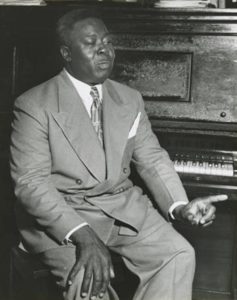Andrew Morgan
Andrew Morgan was a New Orleans traditional jazz clarinetist, saxophonist and audience favorite at Preservation Hall.

Courtesy of Tulane University, William Ransom Hogan Archive of New Orleans Jazz
Andrew Morgan. Crawford, Ralston (Photographer)
Andrew Morgan was a New Orleans traditional jazz clarinetist and saxophonist. He was the brother of Sam, Al, and Isaiah Morgan, all respected jazz performers. A popular showman, Morgan was an audience favorite at Preservation Hall toward the end of his life, where he performed with Kid Sheik Colar’s Storyville Ramblers and with Peter Bocage.
Although recorded information about the date and place of his birth conflicts, Morgan was most likely born on March 13, 1901, in Plaquemines Parish. Morgan’s older brothers, Sam and Isaiah, were both trumpeters, while his younger brother, Al, would learn string bass. Morgan began his musical career on the clarinet but later switched to the tenor saxophone. His playing and methods were guided by the instruction of Paul Chaligny, Joe Watson, Pinchback Touro, and Davey Jones. Morgan was also musically influenced by Earl Fouché.
Morgan’s first public gig was playing clarinet with the Imperial Band in the mid-1920s, followed by a job with the Young Superior Brass Band in 1924. The following year he joined his brothers’ band, the aptly named Young Morgan Band, which quickly became in demand as a dance ensemble. In 1927 Morgan recorded for Columbia Records as part of the Sam Morgan Jazz Band, which included trombonist Jim Robinson, pianist Osceola Blanchard, saxophonist Earl Fouché, and banjoist Johnny Dave, along with the Morgan brothers. The band toured widely in the area, often performing on riverboats, and competed with Fate Marable’s band for popularity. When Sam Morgan suffered a stroke in 1932, brother Isaiah took over as leader of the group, though it disbanded the following year.
In 1930 Morgan played with Mike DeLay’s band, and during the Great Depression, like many of his peers, he joined the Works Progress Administration band. Morgan performed with Billie and Dede Pierce in 1930s, and in the latter years of that decade he began playing with Kid Thomas’s band in Algiers. Around this time Morgan also performed in the Biloxi, Mississippi, area, where his brother Isaiah was a bandleader. When Morgan returned to New Orleans in the mid-1940s, he enjoyed a string of successful partnerships and subsequent recordings with a long list of noted jazz greats, including Herb Morand, Kid Rena, Alphonse Picou, Peter Bocage, and Kid Clayton. Some years later he would form his own Andrew Morgan Brass Band, which played for events and funerals throughout the city.
In 1958 after a successful stint playing and recording with Louis James’s band, Morgan began playing with the Young Tuxedo Brass Band, taking on the role of bandleader in 1964. As with countless other traditional jazz musicians of this era, Morgan enjoyed renewed interest in New Orleans music during the 1960s. He also played gigs with Percy Humphrey, “Sweet” Emma Barrett, Kid Howard, Alvin Alcorn, the Onward Brass Band, Eureka Brass Band, and Captain John Handy. In the late 1960s Morgan collaborated with an Italian band of New Orleans jazz revivalists called the Louisiana Shakers of Genova, which resulted in an album released by the GHB label. Morgan amazed crowds with feats such as holding a sustained note on the clarinet or saxophone through several choruses of “St. Louis Blues.”
Morgan died on September 19, 1972, in New Orleans.
